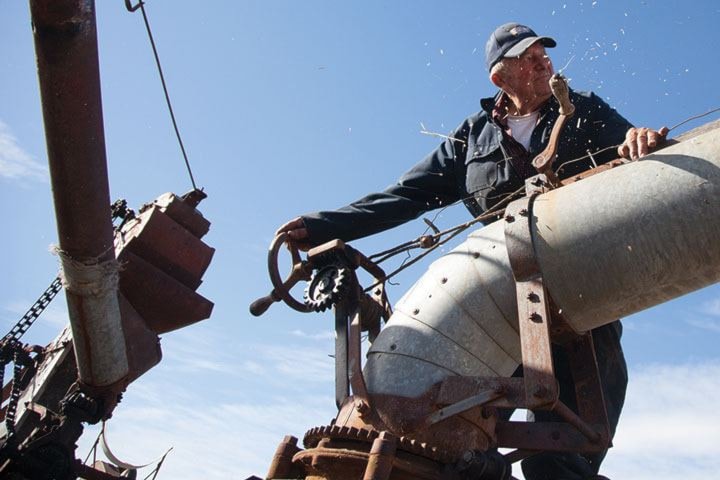On a bright and crispy Saturday afternoon, Oct. 10, the Stettler Antique Tractor Club held its threshing demo as people from Stettler and neighbouring areas came to watch and relive nostalgia and history.
The Stettler Town and Country Museum and the Stettler P and H Elevator Preservation Society partnered with the tractor club to host the event.
"We are organizing this event to preserve the interest of the culture of our ancestors coming into Canada and working together in our world of agriculture," said Walter Haustein, president, Stettler Antique Tractor Club. "It is important to show today's generation what work was done to provide food on the table and to bring back memories of those that laboured through the harvest season, one of the reasons why the public has been offered to fork bundles into the separator."
While lubricating the pulleys on one of the older threshing machines from the 1940s, Haustein explained that during the turn of the century, steam or kerosene powered equipment was used, and Case and International were the "main brands used in this area".
But, when diesel-powered units came in, a segment of history was lost.
"We had the four Clydesdale horses pulling a John Deere binder, cutting and bundling the wheat, while a Massey-Harris 30 pulled a wagon to pick up the bundles and bring to the 1949 22" belt McCormick-Deering separator operated by a John Deere R tractor and this has been traded off with a John Deere 60 tractor," said Haustein, explaining all the intricate machinery. "The grain went into a 1970s Ford 600 grain truck."
The equipment used on Saturday was used to harvest crops up to the 1960s.
According to Haustein, an 18-man crew could then harvest 30-40 acres a day producing 2,000-2,500 bushels of grain, while today with the modern combine operated by a single person, 100 acres can be harvested a day, producing nearly 8,000-10,000 bushels of grain.
There was a small concession where visitors could buy pie, coffee and water, which raised funds of approximately $400.
"The funds raised will be used to expand educational displays and activities of agriculture of the past in the Erichsen Farm Equipment building at the Stettler Town and Country Museum," added Haustein.
There were machines also from the Stettler P and H Elevator Preservation Society, which were being supervised by Stan Eichhorn, president, Stettler P and H Elevator Preservation Society.
Outlining the details of how the tractor club came into being, Karen Wahlund, manager, Stettler Town and Country Museum said, "The Erichsen Farm Equipment building on the Museum grounds was built and donated to the museum with the idea from the donor to create an antique tractor club and to have members restore tractors in the building, thereby creating a work in progress for the museum visitors."
Wahlund added that during the erection of the building that would replicate a John Deere dealership for museum purposes, the goal "was to create educational boards about the agricultural past for visitors and schools to understand more of its creation to today's methods, so any fundraising that the club gathers that is additional to their costs, is re-purposed for these educational boards".
